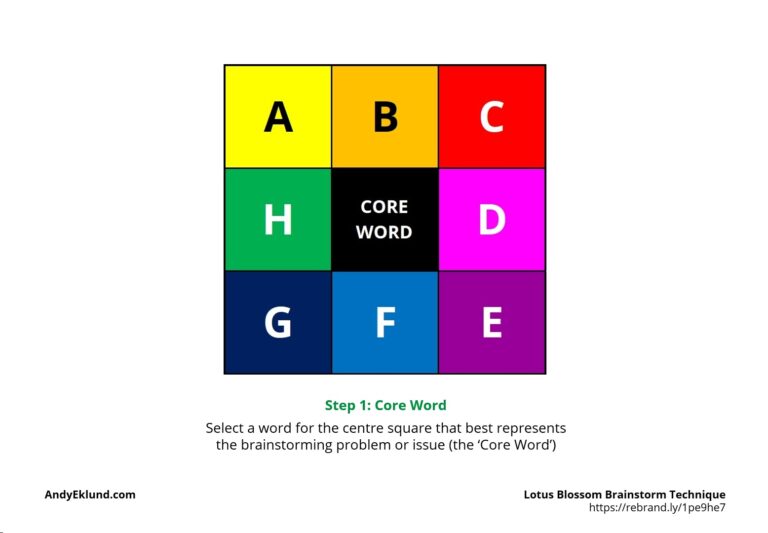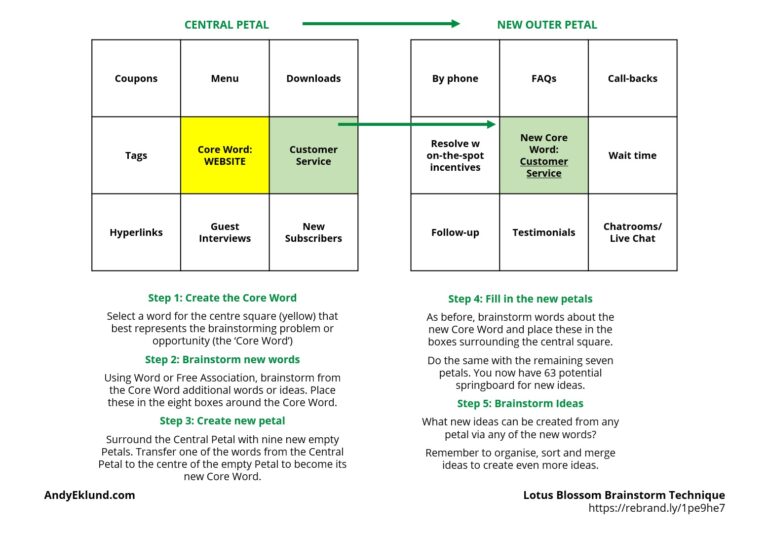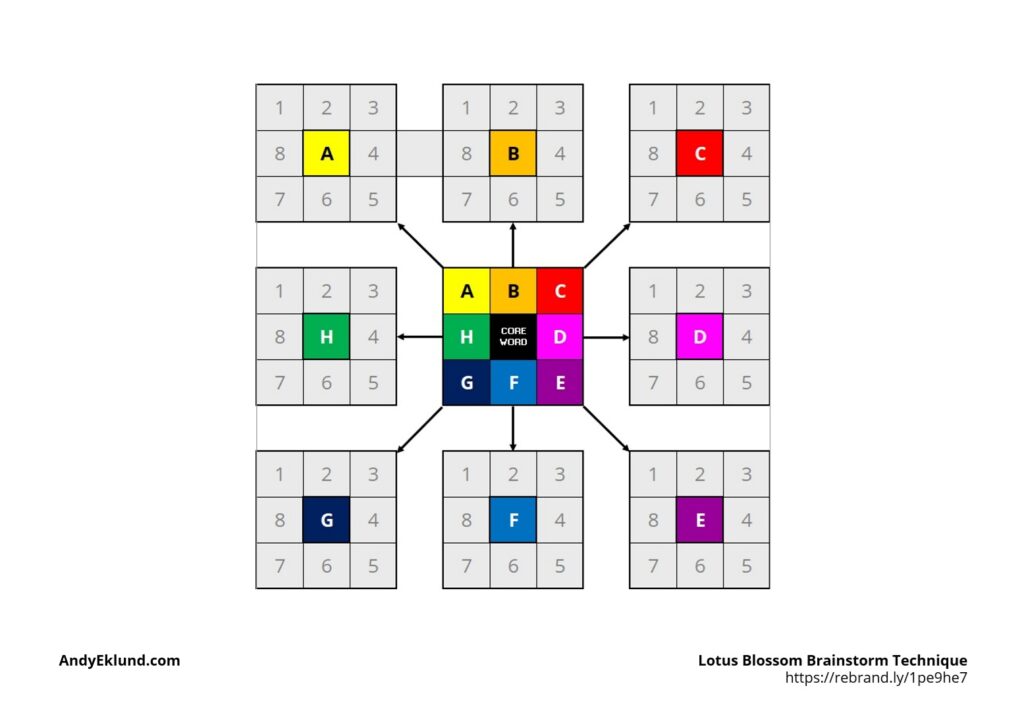Created by Yasuo Matsumura, a management consultant working in Japan, the Lotus Blossom may look elaborate, but it’s a simple creative exercise which uses free association to create ideas.
You begin this brainstorm technique by creating a simple nine-box square on a whiteboard, flipchart or online collab board. Place a core word or idea in its centre, add more words or ideas around the central theme, then add more and more ‘petals’ as the Blossom opens up to create new ideas.
Because the Lotus Blossom is both linear and lateral, it’s an excellent tool for ‘conservative brainstormers’ and ‘left-brain thinkers’ who prefer a creative technique where they see a clear line to idea generation.
In short, the Lotus Blossom is the perfect symbol of Japanese ingenuity: beautiful and practical.
How to Use the Lotus Blossom
Here are the simple instructions.
1. Create the basic Lotus Blossom chart.
Start with the nine-box square in the centre, drawing it on a flipchart page, whiteboard or online collab board.
(For other variations, see below. Scroll to the bottom if you want to download your preferred fill-in-the-blank versions.)
2. State the ‘Core Word’ – one to three words that succinctly define the existing problem, issue or opportunity.
Write or place the problem in the centre of the box.
These outer squares are called petals to keep with the flower theme.
3. Using free association, write a word, idea or concept suggested by the Core Word in the eight boxes surrounding the central box.
You can do this in two ways:
- Select eight random words immediately, or
- Brainstorm many options, then select the eight most provocative responses.
Now it’s time to expand the Lotus Blossom outwards.
4. Arrange eight new nine-box squares around the central box, and transfer the words from the central box to the centre of the outer boxes.
See chart above where ‘A’ from the central square becomes the centre of the outer square, etc. (That’s why using post-its are great to make the movement outward easier to new petals.)
As before, brainstorm eight words or concepts around each of the outer ring petals. If you want, you can continue to build out as many new petals as you like by simply transferring any word or concept to a new empty square.
If you only finish the central box and a new ring of eight 9-square boxes, you will have at least 64 potential prompts and directions to kick-start your brainstorming.
5. Sort, organise, adjust and continue brainstorming.
With at least 64 prompts, you likely will find …
- Duplication (keep the one which best describes the idea and remove the others)
- Items which are sequential (organise them: by steps, by method, be timings)
- Similar ideas (try to merge, adjust and combine them into better ideas)
- Provocative ideas (they don’t work ‘as is’ – but could be brainstormed further)
Remember: keep going back to the Core Word to ensure your ideas are helping to address the real problem or leverage the opportunity.
Variations and Practical Examples of the Lotus Blossom
The Chart Itself
As for variations to the basic structure …
- Create the Lotus Blossom in an Excel spreadsheet
- Fold any piece of regular-sized paper into thirds, both vertically and horizontally, to create nine boxes within its folds. This is particularly helpful for a small group working around a table. Print mini-versions of the Lotus Blossom for partipants to share around a table, oftentimes passing their Blosssom to the next for others to contribute and build upon ideas.
- For a large meeting, create a super-sized Lotus Blossom on a broad wall, using different colours Post-It Notes for the petals.
- I did this for the insurance client (below) with a super large-scale version on a conference room wall in full-colour. It was both interactive and inspiring. I remember watching how people from different teams started working on their own, linking words from different petals and create ideas. It almost facilitates itself.
- Download your preferred fill-in-the-blank versions at the links below.
Client Example
We were hired by an established insurance company to rename the organisation. The team would be full of – using their own words – very linear thinkers. After a short explanation of the technique, the central word chosen was – no surprise – insurance. The next eight words were also obvious. They chose words specific to their brand, values and customer services: security, policy, life, gift, safety, premium, health and protection.
The brainstorm got interesting when different teams expanded the petals from its first ring. From security, one team created these eight words: lock, key, rope, safe, light, guard, measure and alarm. They became preoccupied with the word light, even going so far as to translate light into other languages. From different words for light, the team used the Lotus Blossom to expand further, eventually tweaking and stylising words by removing letters or coming similar words to come up with a unique hybrid, eventually the word Verio.
Another team picked up on this team’s success, expanding upon light to come up with the word torch (aka, a flashlight to my American friends). This team created ideas like distributing small key-ring torches as media gifts, a community program to remind families to check that their home torches had batteries in case of emergencies, etc.
Here’s another good post on Lotus Blossom if you want to read more.
Have you tried the Lotus Blossom before? Any other thoughts on how you’ve used it? Please add your thoughts, comments and tips below.





1 Comment
[…] https://andyeklund.com/lotus-blossom/ […]